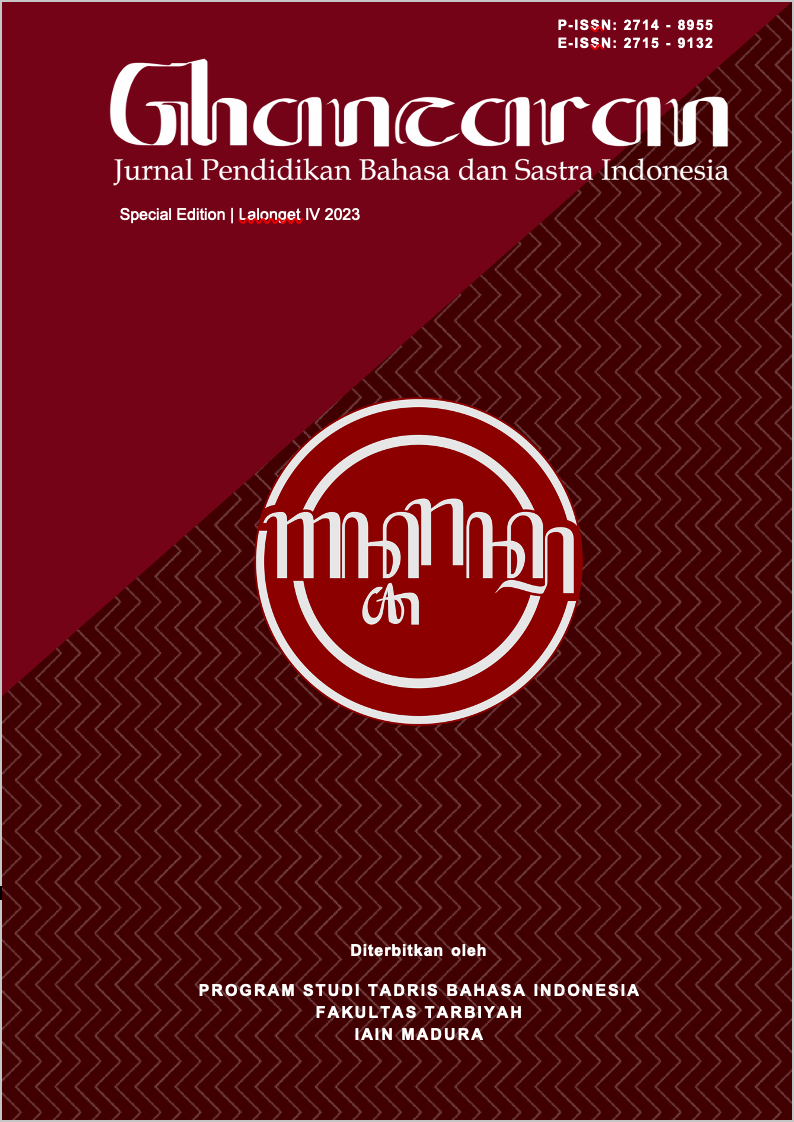Efektivitas Baamboozle terhadap Kemampuan Memahami Teks Cerita Rakyat Sumatera Utara pada Siswa Kelas VII SMP
 Abstract views: 686
,
Abstract views: 686
,
 PDF downloads: 757
PDF downloads: 757
Abstract
The purpose of this study was to determine the effectiveness of bamboozle in learning to understand North Sumatra folklore text in junior high school. This research is an experimental research with one-group pretest-posttest research design. The results of the study concluded that understanding the text of North Sumatra folklore using bamboozle by students of class VII-1 SMP Negeri 1 Delitua obtained an average score of 83.61 while if understanding the text of North Sumatra folklore without using bamboozle by students of class VII-3 SMP Negeri 1 Delitua obtained an average score of 73.12. The bamboozle application is effective in understanding the text of North Sumatra folklore. Significant in this study is 0.001 <0.05 which means Ho is rejected and Ha is accepted, meaning that the bamboozle application is effective to improve students' understanding of folklore text. In this study, there is a significant difference in using bamboozle and without using bamboozle on the ability to understand folklore text by students of class VII-1 and VII-3 SMP Negeri 1 Delitua, namely bamboozle is declared effective in learning to understand folklore text and makes students more enthusiastic in the learning process.
Downloads
References
Alatas, M. A. (2021). Record Slide Show PowerPoint sebagai Alternatif Media Pembelajaran Audio Visual pada Pascapandemi. 1–15. https://doi.org/10.19105/ghancaran.vi.5273
Arikunto, Suharsimi. 2010. Prosedur Penelitian Suatu Pendekatan Praktik. Jakarta: Rineka Cipta.
Arnita. 2013. Pengantar Statistika. Medan: Ciptapustaka Media Perintis.
Arsyad, Azhar. 2003. Media Pembelajaran. Jakarta : PT Raja Grafindo Persada.
Danandjaya, J. 1984. Folklor Indonesia: Ilmu Gosip, Dongeng, dan Lain-lain. Jakarta: Grafiti Press.
Gusnetti, S., & Isnanda, R. 2015. Struktur dan Nilai-nilai Pendidikan dalam Cerita Rakyat Kabupaten Tanah Datar Provinsi Sumatera Barat. Jurnal Penelitian Bahasa dan Sastra Indonesia V1. i2, 183, 192.
Iskandar, S., Rosmana, P. S., Agnia, A., Farhatunnisa, G., Fireli, P., & Safitri, R. 2022. Pengunaan Aplikasi Baamboozle Untuk Meningkatkan Antusias Belajar Siswa di Sekolah Dasar. Jurnal Pendidikan dan Konseling (JPDK), 4(6), 12500-12505.
Miller, John W. dan Micahel M. McKenna. 2016. World Literacy: How Countries Rank and Why It Matters. New York: Routledge.
Rohmatul, A., & Alatas, M. A. (2022). Efektivitas Model Blended Learning terhadap Pemahaman Menulis Cerpen dalam Pembelajaran Daring. GHANCARAN: Jurnal Pendidikan Bahasa Dan Sastra Indonesia, 3(2), 238–249. https://doi.org/10.19105/ghancaran.v3i2.5010
Rukmana Agdiyanti, R., & Effendy Hafid, M. (2020). Penerapan Pendekatan Saintifik dalam Pembelajaran Bahasa Indonesia Siswa Kelas X MA Matsaratul Huda Panempan Pamekasan. 1, 102–111. https://doi.org/10.19105/ghancaran.v1i2.2893
Sa'diyah, I., Savitri, A., Widjaya, S. F. G., & Wicaksono, F. 2021. Peningkatan Keterampilan Mengajar Guru SD/MI melalui Pelatihan Media Pembelajaran Edugames Berbasis Teknologi: Quizizz dan Baamboozle. Publikasi Pendidikan, 11(3), 198-204.
Saud, S., Aeni, N., & Azizah, L. 2022. Leveraging Bamboozles and Quizziz to Engage EFL Students in Online Classes. International Journal of Language Education, 6(2), 169-182. https://doi.org/10.26858/ijole.v6i2.24301.
Semi, M. Atar. 1993. Anatomi Sastra. Padang: Angkasa Raya.
Sukmawati, F. 2021. Media Pembelajaran. Klaten: CV Tahta Media Grup.
Zaini, H., & Dewi, K. (2017). Pentingnya Media Pembelajaran untuk Anak Usia Dini: Raudhatul Athfal. Jurnal Pendidikan Islam Anak Usia Dini, 1(1), 81-96. https://doi.org/10.19109/ra.v1i1.1489
Copyright (c) 2023 GHANCARAN: Jurnal Pendidikan Bahasa dan Sastra Indonesia

This work is licensed under a Creative Commons Attribution-ShareAlike 4.0 International License.
Ghancaran: Jurnal Pendidikan Bahasa dan Sastra Indonesia uses an Open Access Policy under the Creative Commons Attribution-ShareAlike 4.0 International License. Authors publishing in this journal agree to the following terms:
- Ghancaran Journal holds the copyright and grants the journal rights for first publication with the work simultaneously licensed under a

The work is distributed under Creative Commons Attribution-ShareAlike 4.0 International License which allows others to share, copy, and redistribute the material in any media or format and adapt, remix, change, and develop the material even for commercial purposes, as long as it is stated credit and license derivative works under similar terms. - Authors may make additional contractual arrangements for non-exclusive distribution of the journal's published work version.
- Authors are permitted to post their work online (e.g., in institutional repositories or on their websites) before and during submission, as doing so may lead to productive exchange.



















